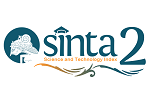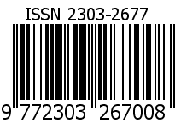Griya Boedaya: komoditas wahana berliterasi budaya sebagai wujud pengenalan budaya lokal di Jawa Timur
Abstract
Keywords
Full Text:
PDFReferences
Arwansyah, Y. B., Sarwiji, S., & Sahid, T. W. (2018). Analyzes the meaning and symbols in stages Yaqowiyu tradition in Klaten. In 3rd International Conference on Art, Language, and Culture (ICALC) 2018. Solo: Perkumpulan Agroteknologi/Agroekoteknologi Indonesia (PAGI).
Arwansyah, Y. B., Suwandi, S., & Widodo, S. T. (2017). Revitalisasi peran budaya lokal dalam materi pembelajaran bahasa Indonesia bagi penutur asing (BIPA). In Proceedings of Education and Language International Conference (pp. 915–920). Semarang: UNISSULA. Retrieved from http://jurnal.unissula.ac.id/index.php/ELIC/article/view/1318/1025
Ayuningsih, S. F. (2017). Pelestarian Rawon Nguling Sebagai nilai tambah pada pengembangan wisata kuliner tradisional Indonesia. Bijak: Majalah Ilmiah Institut STIAMI, 14(1), 108–126. https://doi.org/10.31334/bijak.v14i1.64.g56
Brata, I. B. (2016). Kearifan budaya lokal perekat identitas bangsa. Jurnal Bakti Saraswati (JBS), 5(1), 9–16. Retrieved from http://jurnal.unmas.ac.id/index.php/Bakti/article/view/226/201
Dawood, R., Jackson, S. J., & Yew, J. (2010). Supporting the information needs of mobile microentrepreneurs in the developing world: The case of Indonesian food cart vendors. In Proceedings of the 4th ACM/IEEE International Conference on Information and Communication Technologies and Development - ICTD ’10 (pp. 1–10). London: ACM Digital Library. https://doi.org/10.1145/2369220.2369226
Dwipasari, L., & Subianto, T. (2017). Pendampingan pengembangan KUB (Kelompok Usaha Bersama) Batik Malangan Kota Malang. Jurnal Pengabdian Kepada Masyarakat, 2(2), 42–50. Retrieved from http://jurnal.unmer.ac.id/index.php/jpkm/article/view/1816
Erza, E. K., Yusup, P. M., & Erwina, W. (2017). Komunikasi budaya masyarakat Pandai Sikek dalam melakukan transformasi pengetahuan lokal. Kajian Informasi & Perpustakaan, 5(2), 141–154. https://doi.org/10.24198/jkip.v5i2.10716
Gardjito, M., Putri, R. G., & Dewi, S. (2017). Profil struktur, bumbu, dan bahan dalam kuliner Indonesia. Yogyakarta: Gadjah Mada University Press.
Irianto, A. M. (2016). Komodifikasi budaya di era ekonomi global terhadap kearifan lokal: Studi kasus eksistensi industri pariwisata dan kesenian tradisional di Jawa Tengah. Jurnal Theologia, 27(1), 213–236. https://doi.org/10.21580/teo.2016.27.1.935
Kartikasari, D. W. (2017). Makna motif Batik Gedog sebagai refleksi karakter masyarakat Tuban. Jurnal Kajian Moral Dan Kewarganegaraan, 5(3), 960–974. Retrieved from https://jurnalmahasiswa.unesa.ac.id/index.php/jurnal-pendidikan-kewarganegaraa/article/view/21959/20126
Kementrian Pendidikan dan Kebudayaan. (2017). Materi pendukung literasi budaya dan kewargaan: Gerakan literasi nasional. Retrieved November 10, 2018, from http://gln.kemdikbud.go.id/glnsite/wp-content/uploads/2017/10/literasi-BUDAYA-DAN-KEWARGAAN.pdf
Kistanto, N. H. (2017). Tentang konsep kebudayaan. Sabda: Jurnal Kajian Kebudayaan, 10(2), 1–11. https://doi.org/10.14710/sabda.10.2.%25p
Kurniawan, B. (2012). Ilmu budaya dasar. Tangerang: Jelajah Nusa.
Lisbijanto, H. (2013). Batik. Yogyakarta: Graha Ilmu.
Lusianti, L. P., & Rani, F. (2012). Model diplomasi terhadap UNESCO dalam mematenkan batik sebagai warisan budaya Indonesia tahun 2009. Jurnal Transnasional, 3(2), 1–15. Retrieved from https://ejournal.unri.ac.id/index.php/JTS/article/view/72
Malada, C. A., Hartono, D. D., & Sylvia, M. (2017). Perancangan visual branding Lontong Balap Pak Gendut sebagai kuliner khas Surabaya. Jurnal DKV Adiwarna, 1(1), 11–21. Retrieved from http://publication.petra.ac.id/index.php/dkv/article/view/5494/5025
Moleong, L. J. (2010). Metodologi penelitian kualitatif. Bandung: Rosda Karya.
Mubah, A. S. (2011). Strategi meningkatkan daya tahan budaya lokal dalam menghadapi arus globalisasi. Masyarakat, Kebudayaan Dan Politik, 24(4), 302–308.
Paneli, D. W. W. (2017). Transformasi pertunjukkan wayang orang komunitas Graha Seni Mustika Yuastina Surabaya. JADECS, 2(2), 74–97. Retrieved from http://journal2.um.ac.id/index.php/dart/article/view/2185/1287
Permana, C. Mustikawati, T., & Laksmiwati, T. (2015). Karakter warna batik Malangan sebagai dasar desain interior Galeri Batik Malangan. Jurnal Mahasiswa Jurusan Arsitektur, 3(2), 1–12. Retrieved from http://arsitektur.studentjournal.ub.ac.id/index.php/jma/article/view/111/108
Pratiwi, B. D., & Pinasti, V. I. S. (2017). Pariwisata dan budaya: Studi peran serta masyarakat lokal dalam pengelolaan pariwisata di Kampung Pitu, Nglaggeran, Patuk, Gunung Kidul. E-Societas: Jurusan Pendidikan Sosiologi, 6(8), 1–11. Retrieved from http://journal.student.uny.ac.id/ojs/index.php/societas/article/view/9147/8818
Suneki, S. (2012). Dampak globalisasi terhadap eksistensi budaya daerah. Jurnal Ilmiah CIVIS, 2(1), 307–321. Retrieved from http://journal.upgris.ac.id/index.php/civis/article/view/603/553
Tyas, A. S. P. (2017). Identifikasi kuliner lokal Indonesia dalam pembelajaran bahasa Inggris. Jurnal Pariwisata Terapan, 1(1), 1–14. https://doi.org/10.22146/jpt.24970
Wangge, J. (2013). Perancangan kampanye pelestarian batik belanda sebagai akulturasi kebudayaan Indonesia (Skripsi). Universitas Kristen Maranatha, Bandung. Retrieved from https://repository.maranatha.edu/13027/
Yusup, P. M., & Saepudin, E. (2017). Praktik literasi informasi dalam proses pembelajaran sepanjang hayat. Kajian Informasi & Perpustakaan, 5(1), 79–94. https://doi.org/10.24198/jkip.v5i1.11387
DOI: https://doi.org/10.24198/jkip.v7i1.19428
Refbacks
- There are currently no refbacks.
Copyright (c) 2019 Jurnal Kajian Informasi & Perpustakaan
License URL: https://creativecommons.org/licenses/by-sa/4.0/
Jurnal Kajian Informasi & Perpustakaan Indexed by:
Jurnal Kajian Informasi & Perpustakaan
Program Studi Perpustakaan dan Sains Informasi d.h. Program Studi Ilmu Perpustakaan
Fakultas Ilmu Komunikasi, Universitas Padjadjaran
Jl. Raya Bandung-Sumedang Km. 21 Jatinangor, Sumedang, Indonesia 45363
WA: +62 813-1323-7581 (Chat Only)
Telepon: +62227796954
Faksimile: +62227794122
email: jkip.fikom@unpad.ac.id
Jurnal Kajian Informasi & Perpustakaan is licensed under a Creative Commons Attribution-ShareAlike 4.0 International License
Jurnal Kajian Informasi & Perpustakaan supervised by:












2.png)
.png)



